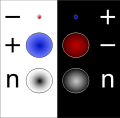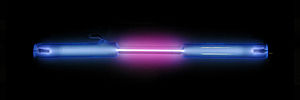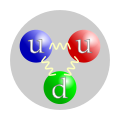associated with an antiparticle with the same mass but with opposite physical charges (such as electric charge). For example, the antiparticle of the electron...
24 KB (2,656 words) - 01:51, 1 November 2024
Annihilation (redirect from Particle–antiparticle annihilation)
process that occurs when a subatomic particle collides with its respective antiparticle to produce other particles, such as an electron colliding with a positron...
12 KB (1,374 words) - 22:31, 2 May 2024
mass 493.677±0.013 MeV and mean lifetime (1.2380±0.0020)×10−8 s. K+ (antiparticle of above) positively charged (containing an up quark and a strange antiquark)...
38 KB (3,195 words) - 12:53, 23 October 2024
muon neutrino, tauon and tauon neutrino), along with the corresponding antiparticle of each of these. Mathematically, there are many varieties of fermions...
7 KB (851 words) - 19:58, 17 November 2024
In modern physics, antimatter is defined as matter composed of the antiparticles (or "partners") of the corresponding particles in "ordinary" matter,...
78 KB (8,053 words) - 04:16, 21 November 2024
Particles have corresponding antiparticles with the same mass but with opposite electric charges. For example, the antiparticle of the electron is the positron...
41 KB (4,203 words) - 23:29, 13 November 2024
matter that is composed of the antiparticles of those that constitute ordinary matter. If a particle and its antiparticle come into contact with each other...
81 KB (9,594 words) - 15:28, 18 November 2024
General antiparticle spectrometer (GAPS) is a planned experiment that will use a high-altitude balloon flying in Antarctica to look for antideuteron particles...
5 KB (492 words) - 22:39, 1 February 2023
backwards. Wheeler suggested that these backwards sections appeared as the antiparticle to the electron, the positron. Many more electrons have been observed...
4 KB (523 words) - 20:27, 28 October 2024
(the same as the electron), and the same mass as an electron. It is the antiparticle (antimatter counterpart) of the electron. When a positron collides with...
35 KB (3,805 words) - 22:52, 1 October 2024
fermion is a spin-½ particle (a fermion) which is different from its antiparticle. A vast majority of fermions fall under this category. In particle physics...
1 KB (166 words) - 10:59, 13 August 2023
Recycling antimatter (redirect from Recycling antiparticles)
Recycling antimatter pertains to recycling antiprotons and antihydrogen atoms. Riesselmann, Kurt (February 1, 2002). "Recycling Antimatter Becomes Reality"...
3 KB (192 words) - 21:14, 17 August 2024
own antiparticle. In other words, it remains itself under the charge conjugation, which replaces particles with their corresponding antiparticles. All...
3 KB (284 words) - 14:08, 6 December 2023
Photon (section Antiparticle annihilation)
rays. Photons can also be emitted when a particle and its corresponding antiparticle are annihilated (for example, electron–positron annihilation).: 572, 1114...
107 KB (11,733 words) - 19:42, 21 November 2024
also Dirac fermions; that is, each known fermion has its own distinct antiparticle. It is not known whether the neutrino is a Dirac fermion or a Majorana...
33 KB (3,050 words) - 21:20, 17 November 2024
C {\displaystyle {\mathcal {C}}} that transforms a particle into its antiparticle, C | ψ ⟩ = | ψ ¯ ⟩ . {\displaystyle {\mathcal {C}}\,|\psi \rangle =|{\bar...
8 KB (982 words) - 09:50, 19 September 2024
neutrinos. For every lepton flavor, there is a corresponding type of antiparticle, known as an antilepton, that differs from the lepton only in that some...
42 KB (4,301 words) - 08:19, 25 September 2024
in physics, is an effect that occurs when a particle collides with an antiparticle. Annihilation may also refer to: Annihilation (comics), a Marvel Comics...
2 KB (263 words) - 09:44, 15 July 2024
physics, crossing is the property of scattering amplitudes that allows antiparticles to be interpreted as particles going backwards in time. Crossing states...
5 KB (620 words) - 04:48, 31 March 2023
converted into a proton, an electron, and an electron antineutrino (the antiparticle of the neutrino): n → p + e− + ν e This process is mediated by the weak...
14 KB (1,522 words) - 15:16, 13 September 2024
Elementary particle (section Antiparticles)
fermionic antiparticles that correspond to these 12 particles. For example, the antielectron (positron) e+ is the electron's antiparticle and has an...
36 KB (3,518 words) - 17:42, 18 November 2024
accelerators). For every quark flavor there is a corresponding type of antiparticle, known as an antiquark, that differs from the quark only in that some...
77 KB (7,572 words) - 11:54, 18 November 2024
gravitation, electromagnetism, weak interactions, and strong interactions. The antiparticle of the strange quark is the strange antiquark (sometimes called antistrange...
14 KB (1,305 words) - 07:11, 5 September 2024
containing bottom quarks include: B mesons contain a bottom quark (or its antiparticle) and an up or down quark. B c and B s mesons contain a bottom quark along...
11 KB (988 words) - 21:24, 7 October 2024
also referred to as a Majorana particle, is a fermion that is its own antiparticle. They were hypothesised by Ettore Majorana in 1937. The term is sometimes...
42 KB (4,891 words) - 12:08, 10 September 2024
spin of 1 /2. For each neutrino, there also exists a corresponding antiparticle, called an antineutrino, which also has spin of 1 /2 and no electric...
141 KB (14,038 words) - 09:56, 23 October 2024
left-handed components of particles and right-handed components of antiparticles participate in weak interactions in the Standard Model. A consequence...
20 KB (2,619 words) - 11:48, 17 October 2024
simply empty space. Rather, it contains short-lived virtual particle–antiparticle pairs (leptons or quarks and gluons). These short-lived pairs are called...
12 KB (1,693 words) - 23:47, 18 August 2024
gravitation, electromagnetism, weak interactions, and strong interactions. The antiparticle of the up quark is the up antiquark (sometimes called antiup quark or...
12 KB (1,126 words) - 21:01, 19 November 2024
antiquark's baryon numbers cancel. Each type of baryon has a corresponding antiparticle (antibaryon) in which quarks are replaced by their corresponding antiquarks...
16 KB (1,853 words) - 17:37, 18 November 2024














